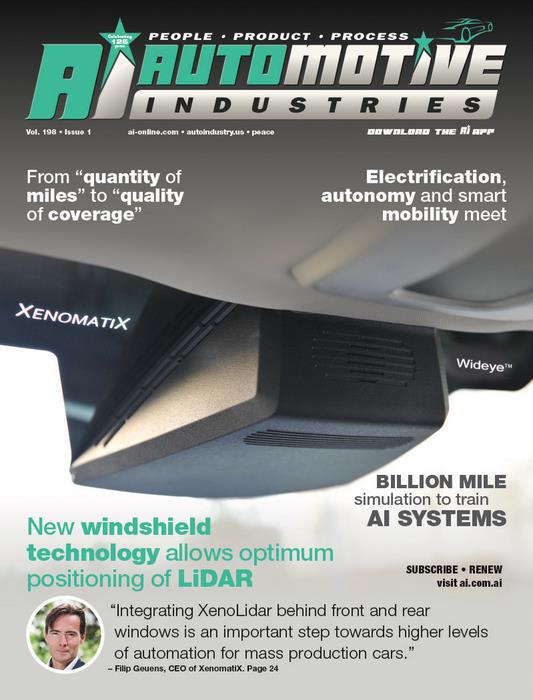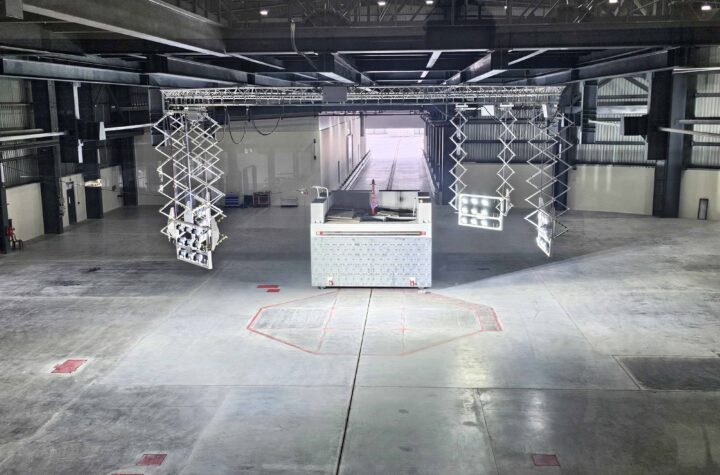
Risk has been reduced for the manufacturers and users of advanced driver assistance (ADAS) and ultimately autonomous vehicles by the development of a windshieldmounted LiDAR system that is protected from dust and dirt. It is the result of partnership between solid-state LiDAR (Light Detection and Ranging) technology provider XenomatiX and AGC, creator of multi-functional automotive glazing technology.
“Integrating XenoLidar behind front and rear windows is an important step towards higher levels of automation for mass production cars,” says Filip Geuens, CEO of XenomatiX. “We are proud AGC selected XenomatiX for a collaboration related to their LiDAR-optimized Wideye™ windshield.” According to AGC Automotive Europe CEO Jean Marc Meunier, Wideye™ is the first windshield which is transparent to infrared LiDAR light.
“This way we tackle multiple concerns from car manufacturers on LiDAR integration, like cleaning the sensor, protecting it, wiring it efficiently, etc. XenomatiX’ concept matches very well with our Wideye™ windshield. Bringing together our expertise will enable car manufacturers to add LiDAR to cars in a clean and trustworthy way.” Geuens says the true solid-state nature of XenoLidar, XenomatiX’s high-performance LiDAR, enables seamless integration behind a vehicle’s windshield. An absence of moving parts, low power consumption and a multi-beam concept go very well together with the Wideye™ windshields offering zero IR absorption combined with a clear view.
Automotive Industries (AI) asked Geuens why LiDAR does not work behind standard auto glass windscreens and rear windows. Geuens: ‘Traditional’ windshields have IR-filters. Visible light is allowed to pass to ensure the human eye and visual cameras can see around the car. However, near-infra red light is blocked to increase passenger comfort. NIR light heats up the interior of the car. Blocking part of the light spectrum makes it easier to control the air temperature inside the car, specifically in summer.
The difference between cameras and LiDARs is the fact that cameras rely on ambient light, while LiDARs send out their own light. Nobody wants the light of the LiDAR to be visible as this would create confusion and distraction. Hence LiDARs use invisible NIR light with a wavelength above the cut-off wavelength of filters that are included in automotive glazing.
AI: Apart from protecting the LiDAR units from the elements what are the advantages of fitting the system inside the vehicle? Geuens: LiDARs replace the human eye when evolving to higher levels of automation. Obviously, these eyes need a clear view at all times and throughout the lifetime of the vehicle. Glass is a very durable material and the infrastructure (such as wipers and spray systems) is already available for assuring an unobstructed view in all circumstances. Moreover, the function of the glass can be extended with coatings, e.g. a coating to heat the windshield for quick defrosting or a coating to reduce the adhesion of dirt, or coatings to improve the performance of the LiDAR. Last but not least, sensors that stick out don’t make cars beautiful. Placement inside the body is far more attractive from an aesthetical point of view.
AI: With the widescale introduction of autonomous vehicles still some way down the track what are the current applications for the integrated XenoLidar-Wideye™ technology? Geuens: Of course, we all dream about a self-driving car solving all our mobility worries. We make ourselves believe we will be working in our car all the time. Well, on my way to CES this year, only a very small minority of the passengers were doing real work, even while they did not have to fly the plane themselves and it was comfortable and stable. I was preparing this interview, but gaming and watching movies is still far more popular. So, I’m a little reluctant about the “gain of time” self-driving cars will bring to humans. Getting to Level 5 is a step-by-step process.
The technology will have to prove its performance and the audience will have to get used to it. Although we like the benefits, most people are not ready yet to hand over the vehicle control to computers in complex traffic situations. So, I expect a more gradual evolution. LiDARs will dramatically increase the performance of ADAS applications. LiDAR can add detection reliability in all ambient light conditions. So, all traditional applications that are covered by camera and/or radar today (such as ACC, ALC, AEB), will become more effective when LiDAR is added.
LiDARs will also reduce damage to cars, especially when maneuvering. As LiDARs are 3D measurement systems they can more precisely locate obstacles such as high curbstones and low poles in time and with high precision. Last, but not least, LiDARs will improve ride comfort by adding intelligence to active suspension.
AI: What has been the response from OEMs? Geuens: Based on past experience and requirements from mechanical LiDARs some OEMs are still under the impression that it is not possible to put a LiDAR behind the windshield. The most powerful division of the OEMs is the design division. They have been apprehensively seeing how prototype self-driving cars have been equipped with sensors sticking out of the car body. This has been done to give the sensors a clear and unobstructed view, but also because windshields influence the performance of the LiDAR. In addition to the absorption of light the challenge is the diffraction the glass causes, especially on moving laser beams. This diffraction changes the laser beam direction, and as such affects the precision of detected objects in azimuth and elevation direction. The combination of the XenoLidar sensor and the Wideye™ windshield doesn’t suffer from these problems.
A high location of the LiDAR system in the vehicle is favorable for detection of objects at larger distance, requiring an unobstructed field-of-view. The top of the windshield is the highest possible sensor location that respects current esthetical limitations. For all the above reasons, OEMs are positive about this type of LiDAR integration. They have raised some practical challenges: In many cars, the central part of the windshield has already been taken by cameras or rain sensors. This creates some competition for space in that part of the vehicle.
This will be overcome in several ways:
- As sensors become smaller, a single module may host different types of sensor. Our XenoLidar solution for instance, is based on a CMOS detector and is capable of capturing visual 2D images combined with 3D LiDAR pointclouds.
- The LiDAR does not have to be located in the center of the window. It can be put alongside the camera or even in the corner of the windshield, as long as it is within the wiped area.
- I even imagine a sensor bar at the top of the windshield over the entire width of the car, creating enough space to accommodate the sensing technology required for higher levels of automation.
AI: Where do you see the technology first being deployed on a production scale? Geuens: I expect this solution to be in the next generation of mass production cars. The car does not have to be 100% selfdriving to benefit from this technology. The introduction of radar was a nice step forward in terms of active safety. Understanding the distance and relative speed to object and other road users is an essential element. Radar is doing this with a single wave. LiDARs will be doing this with several tens of thousands of individual beams. With so much more detailed data, more tasks from the human driver can be taken over.
AI: You said earlier that LiDAR could improve passenger comfort. Please expand. Geuens: XenomatiX is working on comfort improvement by digitizing the road ahead of the car using a high-precision short range LiDAR. Short range means 75m. For this we work together with manufacturers of active suspension systems. By digitizing the full width of the road, our LiDAR builds up a rolling carpet revealing the geometry of the road. From this, the height profile for each of the wheels is calculated and made available in realtime to the suspension controller. Based on this preview data, the suspension has enough time to adjust and keep the body stable. Basically, a preview LiDAR turns an active suspension into proactive suspension.









More Stories
MESSRING completes new crash test facility for Mahindra in India
ROHM Develops an Ultra-Compact MOSFET Featuring Industry-Leading* Low ON-Resistance Ideal for Fast Charging Applications
More than 30 of the top 50 global suppliers have production facilities in Turkey